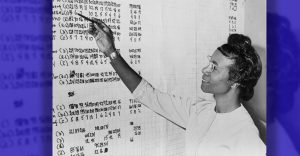Technology
Online Common Core Testing Lays Bare Tech Divide in Schools

In this April 30, 2015 photo, Leticia Fonseca, 16, left, and her twin sister, Sylvia Fonseca, right, work in the computer lab at Cuyama Valley High School after taking the new Common Core-aligned standardized tests in New Cuyama, Calif. The Cuyama Joint Unified School District is 60 miles from the nearest city and has Internet connections about one-tenth the minimum speed recommended for the modern U.S. classroom. Across the country, school districts in rural areas and other pockets with low bandwidth are confronting a difficult task of administering new Common Core-aligned standardized tests to students online. (AP Photo/Christine Armario)
CHRISTINE ARMARIO, Associated Press
SALLY HO, Associated Press
NEW CUYAMA, Calif. (AP) — Nestled between mountains 60 miles from the nearest city, students at Cuyama Valley High School use Internet connections about one-tenth the minimum speed recommended for the modern U.S. classroom.
So when it came time to administer the new Common Core-aligned tests online, the district of 240 students in a valley of California oil fields and sugar beet farms faced a challenge.
New Cuyama has no access to fiber optic cables. Some residents live entirely off the grid, relying on solar power and generators. The local telephone company provided a few extra lines, but that only bumped speeds a few megabits.
“We tripled our capacity but it’s still woefully inadequate,” said Paul Chounet, superintendent of the Cuyama Joint Unified School District.
Across the country, school districts in rural areas like New Cuyama and other pockets with low bandwidth are confronting a difficult task: Administering the new standardized tests to students online, laying bare a tech divide in the nation’s classrooms.
Overall, 63 percent of public schools don’t have access to broadband speeds needed for digital learning. The problem is particularly acute in rural and low-income districts: Only 14 percent in those areas meet high-speed internet targets.
“It’s just very uneven all over the country,” Lan Neugent, executive director of the non-profit State Educational Technology Directors Association.
The Federal Communications Commission approved a $1.5 billion spending cap increase for school broadband and Wi-Fi last year that is expected to significantly boost connectivity. State grants linked to Common Core implementation and collaborations with tech and business leaders are also bridging the gap. But those initiatives could take a year or more to connect thousands of schools and testing started in 29 states and the District of Columbia for 12 million students this year.
In the meantime, they’re resorting to alternatives: Testing students in small groups, busing them to other schools and limiting all other internet access while exams are taken.
On a recent testing day in New Cuyama, 11 students filed into the high school’s small computer lab. Even with such a small number of test takers, students said they’d gotten kicked offline and had to log in again.
“It got me off track,” said Brian Olivas, 17.
The Common Core standards adopted in 43 states and the District of Columbia provide uniform benchmarks for what students should know in each grade in reading and math. To aid their adoption, two groups of states received grants from the U.S. Department of Education to develop new assessments required to be computer based.
By administering the tests online, educators can test more skills. Students can be asked, for example, to demonstrate how they would conduct a science experience or solve a math problem, rather than just bubble in an answer.
Some states were already administering their tests by computer. The vast majority, however, had to quickly bring their technology and infrastructure up to speed.
A survey by the Center for Education Policy found most districts had concerns about hardware and internet speeds and more than half said they didn’t expect to have the technology infrastructure in place to administer the test until this year or later.
The tech challenges come as the Common Core standards and testing face continued resistance. Thousands of parents in New York and a handful of other states chose to opt their children out of the new exams this year. And the standards have already become fodder for the 2016 presidential elections, with early Republican contenders like senators Marco Rubio and Ted Cruz dismissing them as a federal intrusion forced on students, even though they were adopted by states.
Ideally, technology can help eliminate achievement gaps between poor and rural students and their more affluent peers. The shift to online testing, however, reveals how wide the digital divide remains. Districts like Chicago Public Schools with large numbers of low-income students have raised questions about whether their students — who often don’t have access to a computer or the Internet at home — are at a disadvantage.
“The implementation of Common Core is bringing these issues more to the forefront,” said Ryan Smith, executive director of the nonprofit Education Trust-West. “But this has been an issue that has plagued communities of color and low income communities for years.”
Nevada, Montana and North Dakota all dealt with crippling outages at the hands of their test maker, Measured Progress and Smarter Balanced consortium, believed to be linked to a server capacity issue traced down to initial coding problems. Florida, Colorado, New Jersey and other states also experienced glitches.
In light of those issues, some districts have resorted to the paper test.
In New Cuyama, Chounet expects to get internet speeds up to the recommended 100 megabits per second by next year with the help of a state grant that will connect schools to higher bandwidth.
Chounet said those updates can’t come quick enough.
“Even though we’re isolated we have to provide students the technology skills,” he said. “When they leave here, that’s going to be the expectation.”
_
Associated Press writer Sally Ho reported from Las Vegas.
_
Follow Christine Armario on Twitter: http://www.twitter.com/cearmario
Follow Sally Ho on Twitter: http://twitter.com/1sallyho
Copyright 2015 The Associated Press. All rights reserved. This material may not be published, broadcast, rewritten or redistributed.
Alameda County
OPINION: Argent Materials Oakland CleanTech Community Asset Helps Those In Need
Alameda County Supervisor Lena Tam had this to say about Argent Materials as an Oakland community asset: “Congratulations to Argent Materials and its President and Founder, Bill Crotinger! The company is now fully operational, recycling an impressive 99.99% of concrete and asphalt debris, which helps divert thousands of tons of construction waste from landfills. They are also proud to announce that 50% of their team consists of local hires. In celebration of Thanksgiving, and despite stormy weather last week, the Alameda County Sheriffs, alongside Mr. Crotinger and Argent Materials’ dedicated staff distributed turkeys and pies as a heartfelt gesture of gratitude to the community.”

Zennie Abraham
CEO, Zennie62Media
Argent Materials, the Oakland business that turns old concrete and asphalt into new construction products, generally goes by “Argent Materials Oakland CleanTech” but should be called “Argent Materials East Oakland CleanTech for The Community”. Here’s why.
First, Argent Materials is located at 8300 Baldwin St, right in the Coliseum Industrial Zone, just a three-minute drive from the Oakland-Alameda County Coliseum Complex. That’s in East Oakland, and just a city-block walk from the Oakland Coliseum BART Station.
Second, Argent Materials has been a friend to East Oakland and what some, like the members of the Oakland Private Industry Council, would call a “community asset”. In 2024, Argent Materials founder and President Bill Crotinger was named Leader of the Year by the Oakland Private Industry Council (OPIC) “I was humbled and honored to be named Leader of the Year by the Oakland Private Industry Council. Truly an honor. My heartfelt thanks to my friend and mentor Pastor Raymond Lankford and all the wonderful people at OPIC.”
Alameda County Supervisor Lena Tam had this to say about Argent Materials as an Oakland community asset: “Congratulations to Argent Materials and its President and Founder, Bill Crotinger! The company is now fully operational, recycling an impressive 99.99% of concrete and asphalt debris, which helps divert thousands of tons of construction waste from landfills. They are also proud to announce that 50% of their team consists of local hires. In celebration of Thanksgiving, and despite stormy weather last week, the Alameda County Sheriffs, alongside Mr. Crotinger and Argent Materials’ dedicated staff distributed turkeys and pies as a heartfelt gesture of gratitude to the community.”
ABI Foundry reports that Argent Materials led a community clean up for the residents and businesses of Russett Street as well as San Leandro Street. An ABI Foundry team member said “Bill Crotinger at Argent Materials spearheaded the initiative to clean San Leandro street, from Hegenburger to 98th Ave. along the side of BART. AB&I enjoyed participating along with Acts Full Gospel C.O.G.I.C (Men of Valor), Good Hope Missionary Baptist Church-Oakland (Reverend Michael Jones) and Argent Materials. You should see how it looks now. It is AMAZING! It takes an ambitious mind to make a difference block by block.”
What Is Cleantech And Why Is It Important to Oakland And Argent Materials?
Clean technology (Clean Tech) refers to products, services, and processes that mitigate negative environmental impacts by increasing energy efficiency, promoting resource sustainability, and minimizing waste and pollution, ultimately contributing to a low-carbon, and more sustainable economy.
What is The Clean Tech of Argent Materials of Oakland?
In Argent Materials’ context, “cleantech” refers to their sustainable business model which includes recycling concrete and asphalt into new aggregate materials, diverting waste from landfills, and using renewable diesel for their fleet to achieve carbon neutrality and protect the environment. This business approach Argent Materials uses aligns with the broader definition of cleantech, which involves products, services, and processes that reduce negative environmental impacts through resource efficiency and environmental protection
Clean Tech, or green tech as Argent Materials of Oakland does it, is defined as any technology that minimizes negative environmental impact by reducing human consumption of natural resources and by promoting more sustainable and efficient resource use.
Argent Materials will continue to be a cleantech community asset to Oakland well into the future.
Stay tuned.
Activism
Golden State Warriors Program Is Inspiring Next Generation of Female Engineers
Breaking down barriers and biases that deter young girls from pursuing STEAM subjects is essential for creating a level playing field and ensuring equal opportunities for all. By challenging stereotypes and promoting a culture of inclusivity and diversity in STEAM fields, experts believe young girls can be empowered to pursue their interests and aspirations without limitations confidently. Encouraging mentorship, providing access to resources, and celebrating girls’ achievements in STEAM are all crucial steps in creating a supportive environment that fosters success.

By Y’Anad Burrell
The Golden State Warriors and e-commerce giant Rakuten are joining forces to inspire the next generation of female engineers through Building STEAM Futures, part of The City Calls campaign.
Organizers say the initiative is founded on the idea that science, technology, engineering, arts, and mathematics (STEAM) are crucial fields for innovation and progress, and empowering young girls to pursue careers in these areas is more important than ever. Studies consistently show that girls are underrepresented in STEAM fields, resulting in a gender disparity that limits potential and hinders diversity.
Breaking down barriers and biases that deter young girls from pursuing STEAM subjects is essential for creating a level playing field and ensuring equal opportunities for all. By challenging stereotypes and promoting a culture of inclusivity and diversity in STEAM fields, experts believe young girls can be empowered to pursue their interests and aspirations without limitations confidently. Encouraging mentorship, providing access to resources, and celebrating girls’ achievements in STEAM are all crucial steps in creating a supportive environment that fosters success.
On Saturday, March 8, International Women’s Day, the Warriors and Rakuten hosted 20 middle school girls from Girls Inc. of Alameda County at Chase Center’s Above the Rim for a hands-on bridge-building experience. The young girls from Girls, Inc. of Alameda County had an opportunity to design, build and test their own bridge prototypes and learn the fundamentals of bridge construction from the Engineering Alliance and the UC Berkeley Steel Bridge Team.
This STEAM experience for the girls followed the first session in January, where they took a behind-the-scenes tour of the Golden Gate Bridge, learning about its design and construction from industry experts. The City Calls campaign, tipped off with the unveiling the Warriors’ new bridge-themed City Edition jerseys and court design earlier this year.
Activism
Self-eSTEM Empowers BIPOC Women, Girls in Science, Math
In January 2025, Self-eSTEM will launch digital and generative AI programming, which provides digital literacy and AI literacy training through an entrepreneurial project-based activity. This programming will be a hybrid (i.e. in-person and online). Additionally, thanks to a grant from Comcast, in spring 2025, the organization will have a co-ed series for middle and high school students.

By Y’Anad Burrell
Special to The Post
In a world where technology plays an increasingly central role in all aspects of life, the importance of Science, Technology, Engineering, and Math (STEM) education cannot be overstated. Recognizing the significance of STEM for the future, focusing on young women and girls is a critical step in achieving gender equality and empowering the next generation.
Self-eSTEM, an Oakland-based non-profit organization, was founded by Adamaka Ajaelo, an Oakland native who had a successful corporate career with several Bay Area technology and non-tech companies. Ajaelo boldly decided to step away from these companies to give 100% of her time and talent to the non-profit organization she started in 2014 in the belief that she can change the game in innovation and future STEM leaders.
Over the course of a decade, Ajaelo has provided futurist tech programming to more than 2,000 BIPOC women and girls. The organization has an Early STEM Immersion Program for ages 7-17, Emerging Leaders Workshops for ages 18-25 and volunteer network opportunities for ages 25 and up.
In January 2025, Self-eSTEM will launch digital and generative AI programming, which provides digital literacy and AI literacy training through an entrepreneurial project-based activity. This programming will be a hybrid (i.e. in-person and online). Additionally, thanks to a grant from Comcast, in spring 2025, the organization will have a co-ed series for middle and high school students.
While the organization’s programs center on innovation and technology, participants also gain other valuable skills critical for self-development as they prepare for a workforce future. “Self-eSTEM encourages young women to expand on teamwork, communication, creativity, and problem-solving skills. The organization allows young women to enter STEM careers and pathways,” said Trinity Taylor, a seventh-year innovator.
“Our journey over the last decade is a testament to the power of community and opportunity, and I couldn’t be more excited for what the future holds as we continue to break barriers and spark dreams,” said Ajaelo.
“By encouraging girls to explore STEM fields from a young age, we foster their intellectual growth and equip them with the tools needed to thrive in a competitive global economy,” Ajaelo says.
Empowering young girls through STEM education is also a key driver of innovation and progress. When young women and girls are encouraged to pursue careers in STEM, they bring unique perspectives and problem-solving approaches to the table, leading to more diverse and inclusive solutions. This diversity is crucial for driving creativity and pushing boundaries in scientific and technological advancements.
Self-eSTEM has fundraising opportunities year-round, but year-end giving is one of the most critical times to support the program. Visit www.selfestem.org to donate to the organization, as your generosity and support will propel programming support for today’s innovators.
You will also find more details about Self-eSTEM’s programs on their website and social channels @selfestemorg
-

 Activism4 weeks ago
Activism4 weeks agoOakland Post: Week of November 12 – 18, 2025
-

 Activism3 weeks ago
Activism3 weeks agoIN MEMORIAM: William ‘Bill’ Patterson, 94
-

 Activism4 weeks ago
Activism4 weeks agoHow Charles R. Drew University Navigated More Than $20 Million in Fed Cuts – Still Prioritizing Students and Community Health
-

 Bay Area4 weeks ago
Bay Area4 weeks agoNo Justice in the Justice System
-

 #NNPA BlackPress3 weeks ago
#NNPA BlackPress3 weeks agoLewis Hamilton set to start LAST in Saturday Night’s Las Vegas Grand Prix
-

 #NNPA BlackPress2 weeks ago
#NNPA BlackPress2 weeks agoBeyoncé and Jay-Z make rare public appearance with Lewis Hamilton at Las Vegas Grand Prix
-

 Activism2 weeks ago
Activism2 weeks agoOakland Post: Week of November 19 – 25, 2025
-

 #NNPA BlackPress4 weeks ago
#NNPA BlackPress4 weeks agoThe Perfumed Hand of Hypocrisy: Trump Hosted Former Terror Suspect While America Condemns a Muslim Mayor

























































